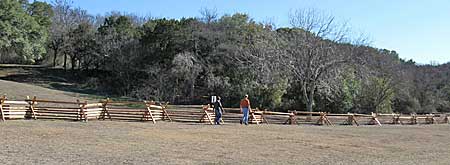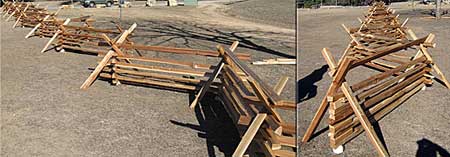Above: The Allied View --- staring into the teeth of Germany’s West Wall
What:
Battle reenactment of 36th Infantry Division’s breakthrough of the Siegfried Line in March 1945. Time Line of Texas military history. American Heroes Celebration and Air Show
When:
Sat. April 18, and Sun. April 19, 2009. Set up on Friday April 17.
Where:
Camp Mabry in Austin, Texas.
Camp Mabry is located on 35th Street, just west of Loop One North (MoPac).
Why:
To honor our veterans, educate the public on the full range of Texas military history, and support the men and women wearing the uniform today.
Host:
Camp Mabry, Texas Army and Air National Guard, Texas Military Forces Museum
Event Coordinator:
Jeff Hunt. Email: [email protected] Phone: 512-782-5770
Who:
All living history groups and military vehicle collectors or clubs related to Texas military history are invited to attend. This includes: Texas Revolution, Indian Wars, Mexican-American War, War Between the States, Spanish-American and Philippine-American Wars, World War I, World War II, Cold War, Korean War, Vietnam War. All Allied and Axis World War II impressions welcome. Civilian impressions relevant to the above also welcome.
Registration Fee:
None
Registration:
Required. Please register for the event here.
Amenities:
Access to showers and indoor latrines, shaded display and camping area, nearby parking, realistic WWII battlefield, free access to all American Heroes Celebration and Muster Day events on Camp Mabry, free breakfast and dinner for all registered participants on Sat. and Sun., free tours of the Texas Military Forces Museum and admission to the museum’s military history book sale. Please plan to eat period rations in your display/camp area as part of your interpretation.
Arrival and Set Up:
17 April. If you wish to stage vehicles, weapons or equipment to Camp Mabry prior to the event weekend arrangements can be made to do so.
Billeting:
No barracks are available for this event. Period camping is allowed and encouraged.
Concept of Operations, Non WWII:
Establish living history camps and displays Provide living history interpretation to military personnel and general public. Area set aside for living history displays is shaded and will boast a newly erected snake rail fence.
Snake Rail fence recently constructed in the 19th Century encampment area
All living history display/camping areas are adjacent to WWII battlefield. Water and portable latrines will be emplaced nearly. Showers, restroom facilities and food vendors will be available elsewhere on post. Different areas will be designated for different time periods and impressions.
There will be a Vietnam War tactical demonstration on Sunday afternoon on the parade ground.
MVPA display area will be on the parade ground behind the reviewing stand.
Concept of Operations, World War II:
Establish living history camps or displays in general area of operations open to the public. Set up of WWII battlefield will occur during the weekend before the event and on Friday April 17.
This will be an intensive scenario of attack and counterattack. The battlefield will be set up much like last year, with dragons’ teeth, barbed wire obstacles and bombed out buildings to be occupied by Axis troops. Participants are encouraged to bring other props and set dressing to help bring the battlefield to life. A way will be found to utilize all vehicles that attend. If enough German vehicles participate we will begin the scenario by having an Axis convoy enter the battle area and deploy troops to their defensive positions. Axis troops may camp in the grassy area alongside 35th Street, or in the area around the battlefield buildings or wood line behind the German positions.
Allied troops will have their positions in the tree line east of the battlefield. There will be a large amount of military pyrotechnics employed during the scenario to depict artillery barrages, Bangalore torpedo explosions and smoke. The battle should last 40 minutes and will end with the Allies taking the buildings and raising the Texas flag over the German headquarters.
Vehicles already committed to the event:
Sherman Tank
U.S. M3 Halftrack
Hetzer
Numerous trucks, jeeps, motorcycles and kubelwagens
General Information:
Firearms and Ammunition: Naturally we encourage you to bring whatever historic firearms are useful for your impression or your encampment. Dummy ammunition is allowed, but absolutely NO LIVE AMMUNITION may be brought on post. If you are bringing a Class Three Firearm on post please have your paperwork on hand in case it is needed.
Campfires: Are permitted, but we are not allowed to dig fire pits on base. If you wish to have campfires please bring an appropriate container in which to build them.
Deportment: We will all be representatives of the Texas Military Forces and our veterans at this event. Please be sensitive as to your language while in front of the public, and treat controversial historical subjects with tact. We ask that you remain in first person character as much as possible while in your display area. No illegal substances of any kind will be permitted on post and speed limits must be strictly observed. We discourage alcohol on post. If you wish to have alcohol in your encampment please practice moderation. Excessive rowdiness, drunkenness, use of illegal substances or unsafe activity with firearms, animals or vehicles will not be tolerated and violators will be asked to leave the post.
Safety: Both your safety and that of the public are paramount. EMTs will be on hand at all times and the nearest hospital is only two blocks away. Proper and safe handling of firearms, animals, vehicles, ammunition and pyrotechnics is expected at all times. No projectiles may be launched from any weapon at any time during the event.
Authenticity of impressions will be strictly enforced. As a public, educational and commemorative event, it is vital that all participants wear correct uniform and equipment for their impression. Hair cuts, mustaches and beards MUST conform to proper military standards for the time period you are representing. This applies to both male and female participants. Watches must also be of period look or vintage. Anachronisms in the camps must be completely hidden during public hours. Rations eaten in display areas must have a period appearance. Authenticity of attitude is also important and everyone wearing a military uniform will be expected to behave in a manner that reflects positively on the armed forces and our veterans. During the battle scenario troops will be expected to act in a realistic manner and follow orders passed through the chain of command. Anyone who cannot adhere to the authenticity and safety standards of the event will be asked to leave.
Rank: You may wear whatever rank, below that of a general officer, which is appropriate to your impression in the display areas. In order to maintain historical authenticity and ensure appropriate command and control during the World War II battle reenactment rank above that of NCO will be assigned by the event staff. A unit that brings 6 to 8 men will be entitled to a Sergeant, a unit with 10 to 18 men will be entitled to a Lieutenant, a unit with 20 or more men may have a Captain. No higher ranks will be permitted on the battlefield without approval. Specialist such as Chaplains, Medical personnel, etc. may wear rank appropriate to their position with approval by event staff.
Organization: We encourage the participation of all units and will respect unit integrity. Units may be grouped together with outfits with similar impressions and assigned a “group” commander to facilitate command and control on the battlefield. Individuals not attached to a standing unit will be assigned to one. Specialist troops (MPs, vehicle crews, chaplains, medical personnel, etc) will be assigned to overall headquarters of both Axis and Allied commands.


